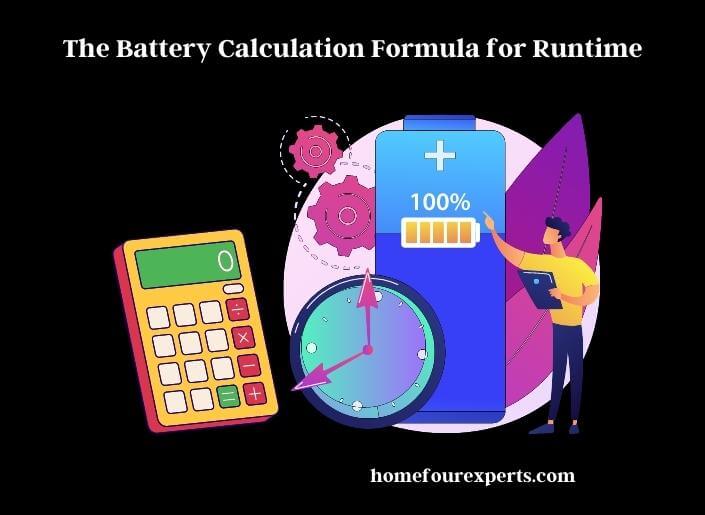Understanding battery runtime is crucial for efficient energy management and planning across various applications, such as solar power systems, electric vehicles, emergency power backup systems, and portable electronic devices. In this blog post, we will introduce the battery calculation formula for runtime, helping you determine how long your battery will last under specific loads.

Battery Runtime Calculator
Key Concepts for Battery Runtime Calculation
Battery capacity (Ah): The battery capacity, measured in ampere-hours (Ah), represents the amount of charge a battery can store. Higher capacity batteries can power devices or systems for longer periods.
Battery voltage (V): The battery voltage, measured in volts (V), signifies the electric potential difference between the battery’s terminals. Higher voltage batteries can deliver more power to connected devices or systems.
Load power (W): The load power, measured in watts (W), refers to the power consumed by the connected device or system. Higher load power results in reduced battery runtime, as more energy is drawn from the battery.
The Battery Calculation Formula for Runtime
The battery calculation formula for runtime is a simple yet effective method to estimate the duration a battery can power a device or system under a specific load. The formula is as follows:

Battery Runtime (hours) = (Battery Capacity (Ah) * Battery Voltage (V)) / Load Power (W)
This formula takes into account the three key factors that influence battery runtime: battery capacity, battery voltage, and load power. By multiplying the battery capacity by the voltage, you can calculate the total energy stored in the battery, measured in watt-hours (Wh). Then, by dividing this value by the load power, you can estimate how long the battery will last under that specific load.
Detailed Breakdown of Each Component in the Formula
Battery capacity: The battery capacity, measured in ampere-hours (Ah), indicates the amount of charge a battery can store. This value represents the current that a battery can deliver continuously for one hour before being fully discharged. For example, a 100 Ah battery can deliver 100 amps of current for one hour, or 50 amps for two hours, and so on.
Battery voltage: The battery voltage, measured in volts (V), specifies the electric potential difference between the battery’s terminals. It determines the amount of energy that can be transferred per unit of charge. For instance, a 12 V battery can deliver more power than a 6 V battery, given the same capacity. Most batteries have a constant voltage, but some may experience a slight drop in voltage as they discharge.
Load power: Load power, measured in watts (W), refers to the power consumed by the connected device or system. This value depends on the energy requirements of the device or system being powered. Higher load power will reduce the battery runtime, as it requires more energy to be drawn from the battery. To calculate the load power, you can multiply the device’s current draw (in amps) by its operating voltage (in volts).
Using the Battery Calculation Formula for Runtime
To use the formula, follow these steps:
- Determine the battery capacity (Ah) and voltage (V) from the battery specifications.
- Calculate the load power (W) by multiplying the current draw (in amps) of the connected device or system by its operating voltage (in volts).
- Plug these values into the formula:
- Battery Runtime (hours) = (Battery Capacity (Ah) * Battery Voltage (V)) / Load Power (W)
The result will give you an estimated battery runtime in hours, which can help you plan your energy usage and manage battery performance accordingly.
Keep in mind that the formula provides an estimate, and actual battery runtime may vary due to factors such as battery efficiency, aging, and environmental conditions.
Example Scenarios for Battery Runtime Calculation
- Solar power systems: Calculate battery runtime to determine the energy storage capacity required for reliable power supply during nighttime or cloudy days.
- Electric vehicles: Estimate the driving range based on the battery runtime, allowing drivers to plan trips and charge stops accordingly.
- Emergency power backup systems: Determine how long a backup system can provide power during an outage, ensuring critical systems remain operational.
- Portable electronic devices: Calculate battery runtime for smartphones, laptops, and other portable devices to manage usage and battery life efficiently.
Practical Tips for Optimizing Battery Runtime
Choosing the appropriate battery type and specifications: Select a battery with the right capacity, voltage, and chemistry to match your specific application.
Effective battery maintenance and storage practices: Follow manufacturer guidelines for charging, discharging, and storing batteries to prolong their lifespan and maintain optimal performance.
Managing connected devices’ energy consumption: Use energy-efficient devices, adjust settings, and turn off unused features to reduce load power and extend battery runtime.
Additional Battery Runtime Considerations
Battery efficiency and energy losses: Consider the battery’s efficiency, as energy losses during charging and discharging can affect the actual runtime.
Battery aging and degradation: Be aware that batteries lose capacity over time, resulting in reduced runtime as they age.
Environmental factors affecting battery performance: Temperature, humidity, and other environmental conditions can impact battery runtime and overall performance.
Conclusion
The battery calculation formula for runtime is a valuable tool for determining how long a battery will last under specific loads, enabling better energy management and planning across various applications. By understanding the factors that affect battery runtime and implementing strategies to optimize it, you can ensure reliable and efficient performance for your devices and systems. We encourage you to apply the battery calculation formula in your projects and experience the benefits of informed planning and energy management.
About This Writer

Hi, I am responsible for the 'Homeowners Power Solutions' category. My name is Liam Jaxon and a licensed technician with 7 years of experience in vehicle batteries, electrical gadgets, and home appliances. My working experience in different residential & light commercial electrical sectors and the automobile industry helped to acquire vast knowledge in this industry.